"His among strangers." Part of 1. Chevalier loser
In this new cycle, which we started with the Belarusian colleague from Brest, Alexander Prokurat, a man who tenderly and reverently adores everything that has caterpillars, I would like to tell you in detail about the following points of the last great war.
As is customary in many books and textbooks, on June 22, 1941, hordes of German poured into our lands across the border tanks. It has been colorfully described in books, it has been shown in films. But there is a nuance. Is it German?
It is no secret that after the First World War, Germany suffered a severe crisis. And the industry was no exception. Yes, the Germans created a lot of really beautiful weaponsThis is an indisputable fact. Qualitative. But quantitatively, alas, Germany “could not”.
Stalin once said the following to the US ambassador in Moscow, Mr. Harriman: "This is a war of motors, whoever has more, will win."
It is difficult to argue with this statement. And even though our direct enemy and enemy of these words could not hear, their very essence was visible in the motley “Panzervaffe” and “Wehrmacht”.
We set our first priority to show that the USSR fought not only with Germany. Our grandfathers and great-grandfathers fought with all of Europe. Which not only provided the combat vehicles at its disposal, but also produced new ones, and diligently repaired the old ones.
Due to the fact that the German industry under the old Reich Minister for armament and ammunition F. Todte was not fully mobilized and transferred to the military rails, she did not have time to close the needs of the army in armored vehicles.
In this regard, the use of captured technology has a very significant effect. The Germans tried to maximize the use of weapons obtained as trophies. And if in the case of Czech tanks, Germany bought them, then after the French campaign in Germany, a huge fleet of armored vehicles was taken.
And since the Germans are a very diligent nation, they used the resulting resource in full. How - we will tell and show.
Naturally, our narratives will not affect those samples that never appeared on the Eastern Front. Let them write about those who fought with them. We will lead the story of those who were burned and shot down by our ancestors.
So, France. And the French chevalier loser "Renault R-35".
As of May 1940, the French army had 2637 new tanks. Mikhail Baryatinsky cites the following data by type and quantity: “314 tanks В1, 210 - åNXXX and D1, 2 - R1070, åR, åÑ, 35 - X308, 35 - S243, 35 - N392, ofntx, opt. In addition, the parks kept up to 38 old FT39 / 40 combat vehicles (including 90 combat-ready) during the First World War and six heavy 2000Cs. The 17 armored vehicles and 18 armored personnel carriers and tracked tractor units complemented the armored ground forces. ”
They were used by the Germans in different ways: carriers of ammunition, tank destroyers, flamethrowing tanks, towers were used to build the Atlantic Wall, to fight partisans, and so on.
The first combat use by the Germans of the tank R-35, in the German classification Panzerkampfwagen 35R (f) or Panzerkampfwagen 731 (f), took place during the French campaign, but in very limited quantities. Then they were supposed to be used in Operation Sea Lion, at least in the exercises in the territory of Northern France in the summer of 1940, these machines were used.
Panzerkampfwagen 35R 731 (f) of the 336 Infantry Division, France, July 1940 of the year.
Part of the tanks was left in France for the protection of Paris, several units went to the 206 tank battalion in Cherbourg. A part was handed over to the Allies, a part was distributed among security units and SS units (used in anti-partisan operations in the Balkans), since the tank was not suitable, according to German standards, for use in the first line on the front.
In total, the Germans got about 800-840 tanks of the Renault R35 type. Most of them required repair and was sent to the Renault plant.
About 200 tanks were converted into specialized vehicles, which took part in the operation “Barbarossa” and in the battles on the Eastern Front. The 110 tanks, with their turrets removed and without ammunition, designated Umbau von Panzerkampfwagen 35R (f), by February 1941 of the year were attached to batteries 150-mm howitzer sFH 18 and more powerful K18 / 21. They were used quite successfully, and by the beginning of the spring 1942, the Wehrmacht had another 52 tractor of this type.
Umbau von Panzerkampfwagen 35R (f) on the Eastern Front, 1941 year
Not without a tow truck, the Germans have always tried to remove damaged and / or damaged equipment from the battlefield. This machine was the Bergeschlepper 35 R (f), from the artillery tractor, he actually did not differ, except for the assigned tasks. Approximately 90 R-35 tanks underwent similar conversion
Bergeschlepper 35 R (f) in the expanses of the Eastern Front.
As stated above, the R-35 tanks could not operate in the first line, so in December Alkett’s 1940 received an order to re-equip around 200 units into self-propelled guns armed with Czech gun PUN vz.47 (the same gun was installed on Panzerjäger I). The car was named 36 cm Pak (t) (Sfl) auf Fgst.Pz.Kpfw.4,7 R 35 (f).
The task of refurbishment was not easy. The R-35 had smaller dimensions than the Pz I Ausf B (the French tank was already 210 mm than the German one). It was necessary to accommodate three crew members and ammunition. Due to the fact that the tower epaulet was too small, they refused to place the shells inside the hull and placed them in a developed niche in the rear part. By the way, the cabin was not attached to the body tightly, at the top of the case there were beams, to which the cabin was fastened on goujonas. Doors were made in the side walls, which facilitated the landing of the crew landing. She also had to make the maximum forward to accommodate the 47-mm gun. In the basic version was built 174 ACS.
4.7 cm Pak (t) (Sfl) auf Fgst.Pz.Kpfw.35 R 731 (f)
In March 1941 of the year, ACS was shown to Hitler, in the same month the first batch of 30 machines was released, by May their number was 93, on 22 June 1941 of the year their number was approximately 126 units. By the end of October, the 74 machines were also transferred to the Wehrmacht. The ACS entered service with the 559 and 561 anti-tank battalions, which were previously armed with towed 3.7 cm Pak Pak 37 guns. A little later, the 661 th anti-tank battalion moved to a new materiel.
All of them took part in the German invasion of the USSR, the 559 th anti-tank battalion was part of the LVI army corps of Army Group North, and the 516 th group of 9 Army Corps and 611 of the XXXXVII army corps were in Army Group Centre".
4.7 cm Pak (t) (Sfl) auf Fgst.Pz.Kpfw.35 R 731 (f) on the Eastern Front
The combat debut of ACS data on the Eastern Front is hardly successful. Within a week and a half after the campaign began, reports began to fall. So, 5 July 1941, the commander of the 611-th battalion reported that the car finally went down in the first days due to various breakdowns. The 561 battalion had a similar situation; in the report of the 9 Army Corps headquarters, it was necessary to re-equip the towed guns.
Another unit, the 318-i company, which was armed with 4.7 cm Pak (t) (Sfl) auf Fgst.Pz.Kpfw.35 R 731 (f), was in the rear of Army Group South. She was able to hold out much longer, reports from February 1942 of the year say that a stalemate has developed in the company. The machines were constantly breaking down due to engine failures, were not able to carry out long marches, especially in winter conditions. The ACS could not be started at –10С, the frozen dirt blocked the rollers, the tracks did not keep the car on the ice, the radio stopped working at –20С.
One conclusion can be made: the crews of these SAUs had to fight more with their materiel than with the enemy, therefore, self-propelled guns of this type were used more actively in the West, but this is different story, we are not very interested.
Together with 4.7 cm Pak (t) (Sfl) auf Fgst.Pz.Kpfw.35 R 731 (f) “fought” and commander vehicles, called Führungs-Fahrzeuge auf Fgst.Pz.Kpfw.35 R 731 (f). They were distinguished from the ACS by the lack of a gun, and the MG-34 machine gun mounted in its place in the Kugelblende 30 ball mount. A total of 26 machines were converted.
In addition to Germany, the R-35 tanks were also in service with its allies: Bulgaria, Romania, Italy (did not take part in the battles on the Eastern Front), as well as Poland. Polish tanks went to Romania after the September 1939 campaign. Not wanting to surrender to the Germans, Polish tankers crossed the Romanian border and were interned, the Romanians got the 34 tank. At the same time, the Red Army got the 2 or 3 of the R-35 tank, which were sent to Kubinka. Bulgaria in April 1941 got 40 captured tanks, did not participate in the battles on the Eastern Front.
Romania stands apart here. Under the rearmament program, it was intended to purchase X-NUMX R-200 tanks from France, as well as to organize joint production in Romania. As a result, the plant was never built, and in 35, the French were able to transfer only the 1930 tank. Of which formed 41 th armored regiment, which by the way included interned Polish tanks. To attack the USSR in the 2-th armored division, 1-th tank regiment which was armed with French tanks.
The 2 Tank Regiment was sent to support the 4 Army Corps, in which it took part in the battles in Bessarabia, and the storming of Odessa, where they were highly appreciated for their ability to resist the Soviet anti-tank guns.
However, low-power 37-mm guns assigned tanks the role of infantry support. After the capture of Odessa, the Romanians wrote off 15 tanks as completely unsuitable for further use, the rest needed major repairs due to heavy wear, and due to combat damage. Romanian industry could not put them into operation until the 1942 year.
Back in December, 1942, it was decided to install on the tank 45-mm guns 20K with captured T-26 and BT-7. The tank is reduced ammunition and removed the machine gun.
The tests take place in February 1943 of the year, and the command of the mechanized troops orders the 33 modified tank. The 45-mm guns were reworked in Targovishte in an army arsenal, the Concordia plant in Ploiesti makes new towers, and the final assembly is carried out in Bucharest. Modified tanks received the designation Vânătorul de Care R35 or R35 / 45.
The tanks hit the 2 armored regiment in June 1944. They joined the battle against units of the Red Army in July 1944 of the year, but after the coup of 23 in August 1944, they began to fight against the Germans.
Stand alone is the tank R-35 with a tower from the T-26 arr. 1939 d. The photo on the network appeared some time ago and is known under the signature “Panzerkampfwagen 35R 731 (f) mit T-26 Turm”. A number of experts, such as Yury Pasholok, consider that the photo is a fake.
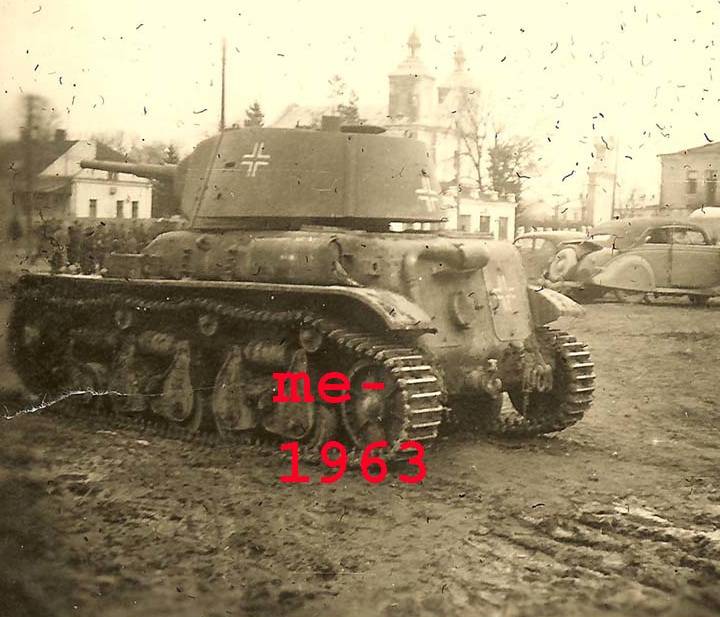
However, David Bokulet from the site of tanks-encyclopedia.com is inclined to the reverse version. The expediency of a fake is doubtful due to the high quality of the photo. If it is fake, then VERY professional.
There are still photos of a tank with a turret from a T-26 tank arr. 1935. Original photo with German soldiers, albeit of mediocre quality, but allowing to draw certain conclusions.
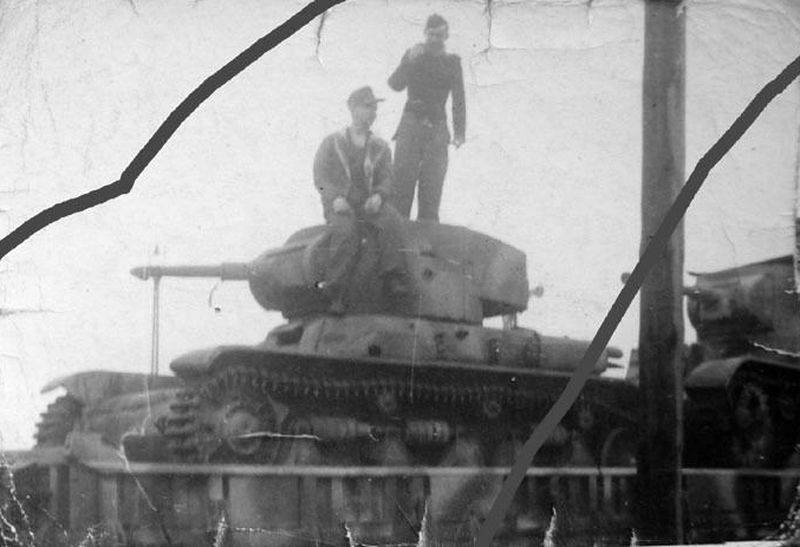
There is no data about the place and time of pictures. Theories of origin, which are at this hour:
1. Romanian. Conversion of a tank with a turret from the T-26 model 1939 of the year, like Vânătorul de Care R35. The weak point is the presence of identification marks Balkenkreuz which the Romanian troops did not use.
2. German. Field conversion of the tank by specialists of the 7 Volunteer Mountain Division of the SS "Prinz Eugen". This unit was armed with various captured weapons, including tanks S-35, H-35 and R-35. However, before the 1944, this unit did not fight with the Red Army units, its main task was the anti-partisan struggle in the Balkans.
TTH:
Weight - 10 tons.
Crew - 2 people.
Dimensions:
Length - 5,0 m.
Width - 1,85 m.
Height - 2,37 m.
Clearance - 0,32 m.
Armament: Puteaux 37 cannon L / 21 SA18 mm and one machine gun Chatellerault 7,5 mm MAC31 "Reibel".
Ammunition: 42 armor-piercing and 58 high-explosive fragmentation projectiles, 2400 ammunition
Booking:
The forehead of the body is 40 mm.
Chassis side - 40 mm.
Body Feed - 32 mm.
The forehead of the tower - 40 mm.
The turret is 40 mm.
Mask gun - 40 mm.
Roof - 25 mm.
Bottom - 10 mm.
Engine: Renault, carburetor, 4-cylinder, power 82-85. with., fuel tank capacity - l. 166.
Speed: 20 km / h on the highway, 14 km / h on the side road.
Power reserve: 130-140 km on the highway, 80-85 km on the side road
Obstacle obstacles:
Wall height - 0,5 m.
Wade depth - 0,6 m.
The width of the moat - 1,5 m.
The result ... The result is simple. The Chevalier loser R35 was still an extremely weak tank. Yes, booking for a light tank of those times was not bad. All the rest - alas. Slow, with a small power reserve, lightly armed, he played second roles. But even the second role, he played poorly, because the bulk remained in the auditorium. That is, on the battlefield.
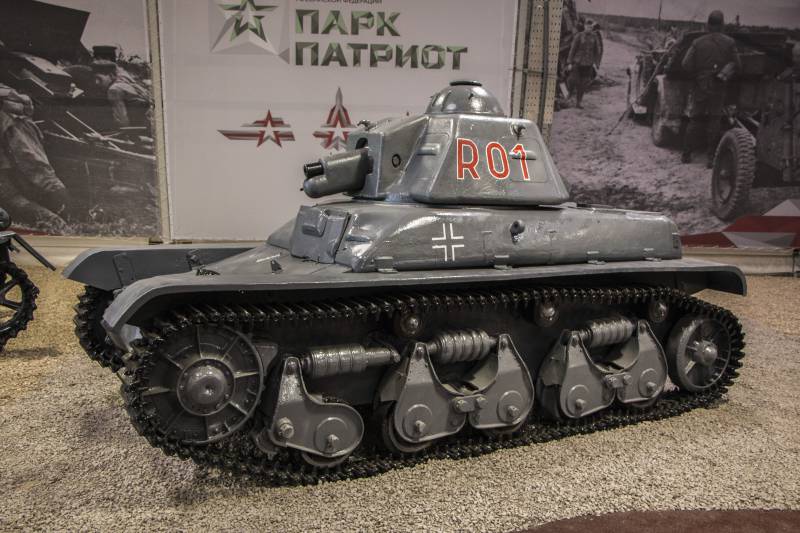
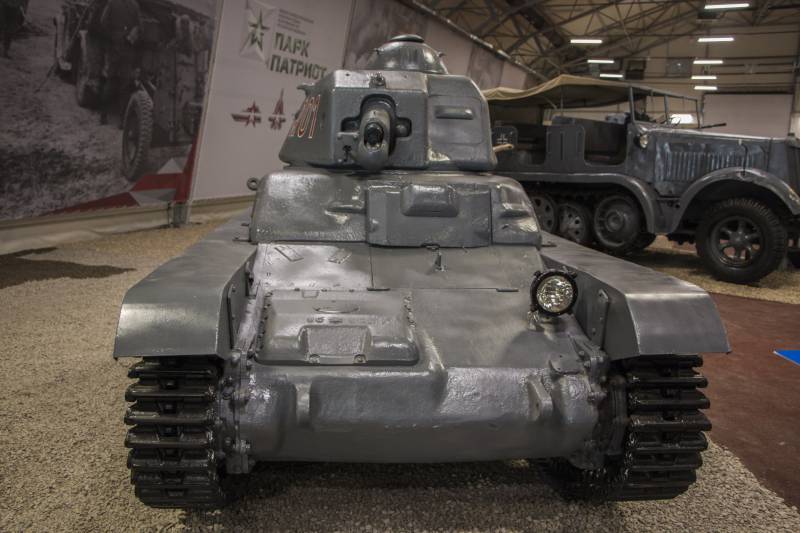

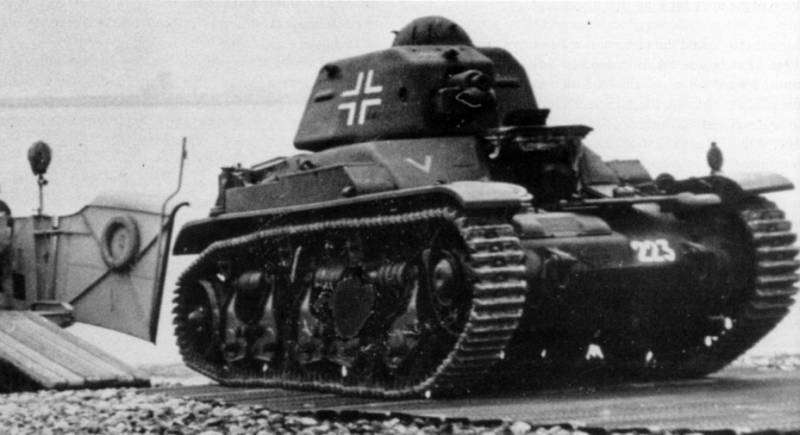
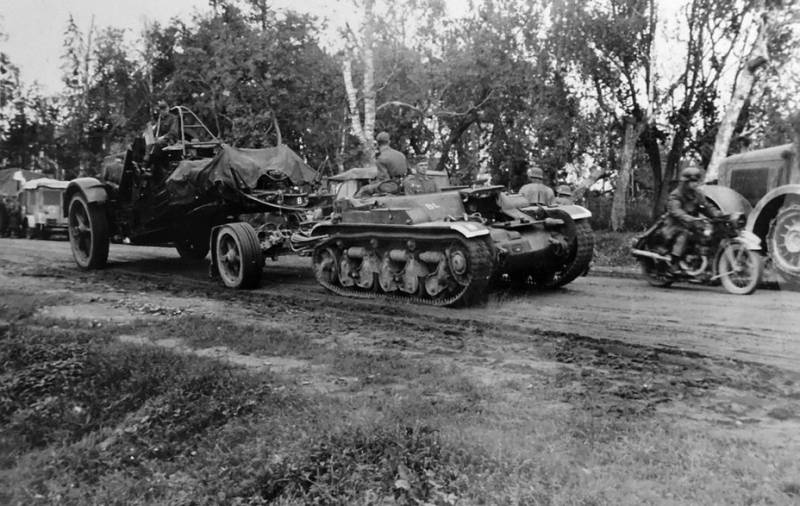
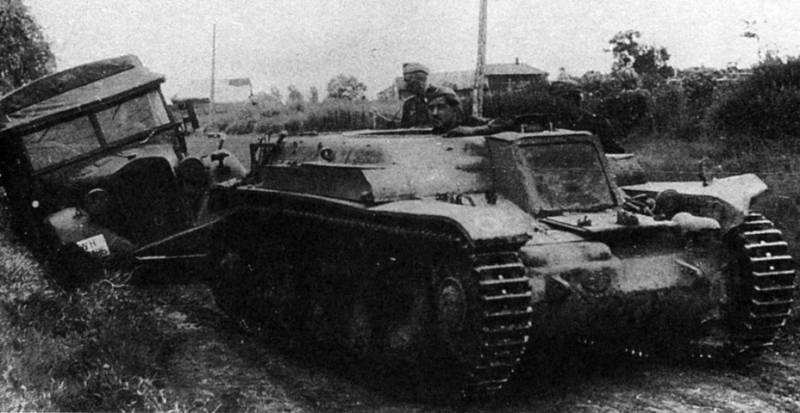

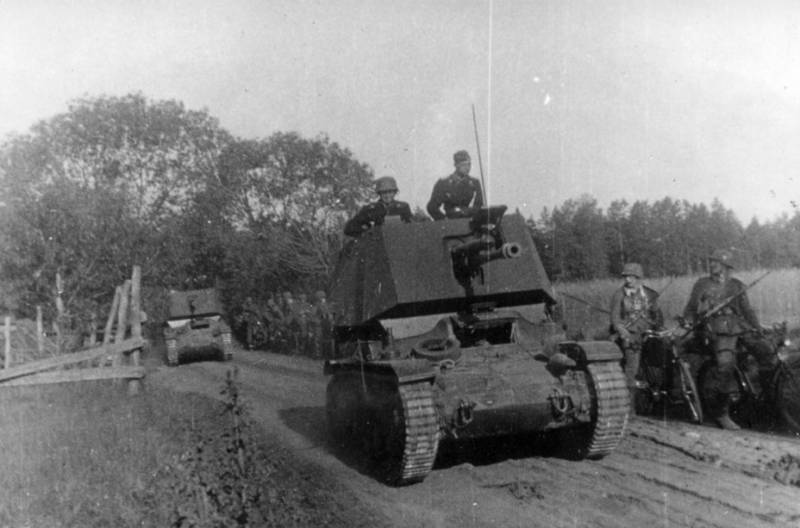
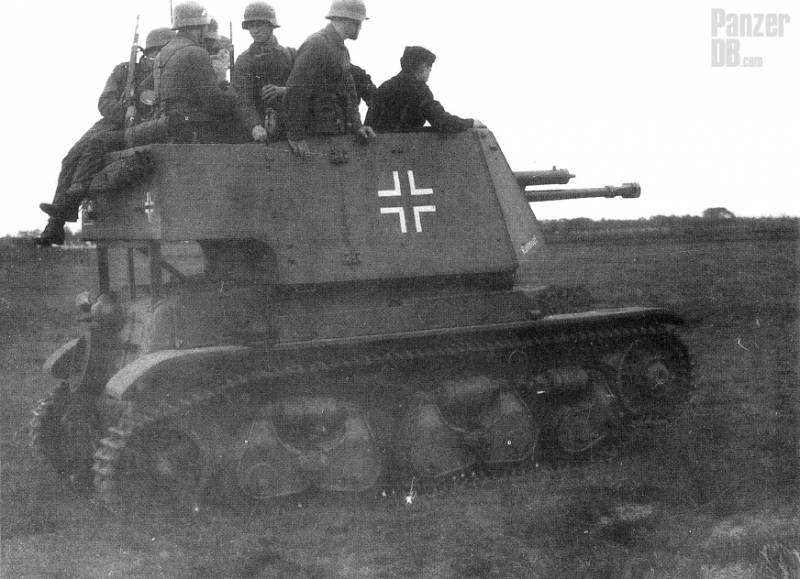
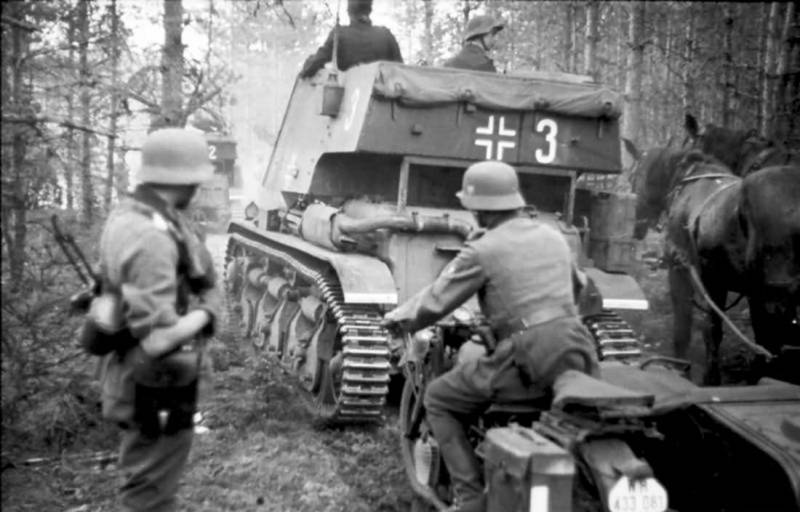
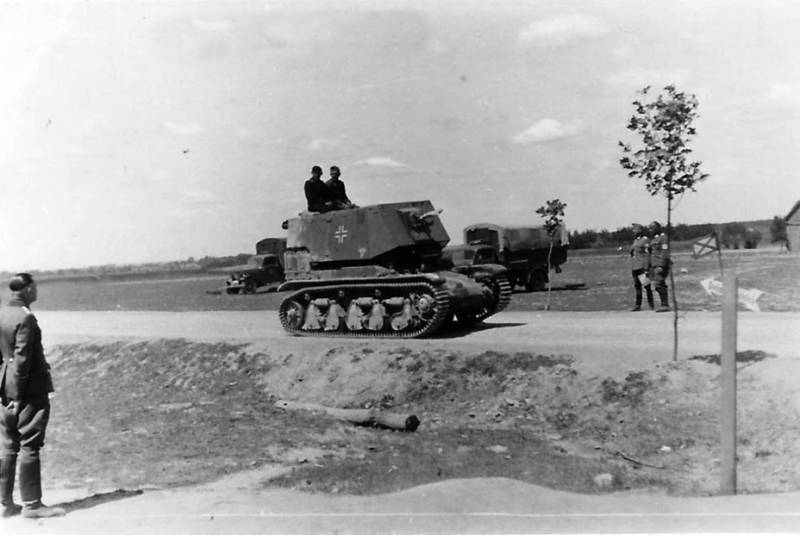
Information